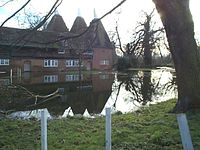Human settlement in England
| Littlebourne | |
|---|---|
 An oast house in Littlebourne An oast house in Littlebourne | |
 | |
| Area | 8.52 km (3.29 sq mi) |
| Population | 1,529 (Civil Parish 2011) |
| • Density | 179/km (460/sq mi) |
| OS grid reference | TR208574 |
| Civil parish |
|
| District | |
| Shire county | |
| Region | |
| Country | England |
| Sovereign state | United Kingdom |
| Post town | CANTERBURY |
| Postcode district | CT3 |
| Dialling code | 01227 |
| Police | Kent |
| Fire | Kent |
| Ambulance | South East Coast |
| UK Parliament | |
| 51°16′36″N 1°10′02″E / 51.2767°N 1.1672°E / 51.2767; 1.1672 | |
Littlebourne is a village and civil parish 4 miles (6.4 km) east of Canterbury in Kent, South East England.
History
The significant Howletts Anglo-Saxon cemetery is in the parish. It is regarded as "Jutish"; finds are in the British Museum and elsewhere, and include two of the very rare quoit brooches.
The manor of Littlebourne belonged to St Augustine's Abbey in Canterbury and the abbot maintained a vineyard there according to Canterbury MP and antiquarian John Twyne in his De Rebus Albionicis.
The viticultural theme is reflected in the parish church's unusual dedication to St Vincent of Saragossa, patron saint of winemakers. The church is in all regards consistent to have been founded by the monks of St Augustine's, which oral history attests, in the 13th century and contains a medieval wall painting depicting Saint Christopher, patron saint of travellers.
References
- Key Statistics; Quick Statistics: Population Density United Kingdom Census 2011 Office for National Statistics Retrieved 21 November 2013
- Smith, Reginald A., "Jutish Finds in Kent", The British Museum Quarterly, Vol. 10, No. 3 (Mar., 1936), pp. 131-132, DOI: 10.2307/4421850. JSTOR; 329 objects in the British Museum
- Hasted, Edward (1800). The History and Topographical Survey of the County of Kent, Volume 9 (2 ed.). W. Bristow. p. 147.
External links
- Littlebourne Parish Church
- Kent Archaeology history of the manor and church
![]() Media related to Littlebourne at Wikimedia Commons
Media related to Littlebourne at Wikimedia Commons
This Kent location article is a stub. You can help Misplaced Pages by expanding it. |
